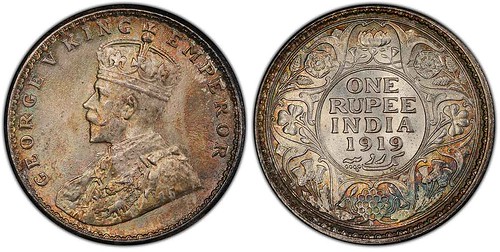
PREV ARTICLE
NEXT ARTICLE
FULL ISSUE
PREV FULL ISSUE
HOW MORGAN DOLLARS BECAME INDIAN RUPEESJay Turner published a PCGS blog article January 29, 2021 based on an obscure fact found in William Silber's 2019 book, The Story of Silver - How Morgan dollars became Indian rupees. -Editor Little thought is given by many on the previous incarnations of the metal that the coins they have once were. Yet, truth be told, the metallic content of many coins cannot be traced to their origins if their sources were previously melted coins – with some exceptions. One such exception entails the silver rupee coins from India, where many of the silver issues of George V after 1917 can trace their silver content back to the United States Morgan Dollar. With the outbreak of World War I, silver coin shortages caused many issues in Europe and other parts of the world. With economies that were dependent on the silver standard, such as the British Colony of India, this was a significant problem. Because of the scarceness of silver, India was having a hard time redeeming its currency for silver upon demand. Nevada Senator Key Pittman introduced the now well-known Pittman Act in 1918, which would allow the United States to loan Great Britain silver bullion from melting United States silver dollars held in Treasury Department vaults. The Pittman Act called for not more than 350,000,000 silver dollars to be converted into bullion and sold to Great Britain at the rate of $1 (plus mint charges) per ounce. With the passage of the Pittman Act, 270,232,722 silver dollars in the Treasury Department vaults in the San Francisco and Philadelphia Mints were melted, with their silver being shipped to Calcutta to be re-coined into India Rupee coins featuring the effigy of King George V. Besides the melting of over 270 million Morgan Dollars, the Pittman Act had other consequences. The Act required that an equal number of Silver Certificate banknotes be removed from circulation due to the inability of redemption because the equivalent silver dollars were no longer in United States holdings. From this, the first Federal Reserve Bank notes were printed in $1 and $2 denominations. Pittman, always the promoter for Nevada silver mining, also required the United States to repurchase the silver at a fixed price of $1 per ounce and the equivalent number of silver dollars to be recoined. This occurred starting in 1921, with the first Morgan Dollar coin to be struck since 1904 and also led to the introduction of the United States Peace Dollar, which was minted from 1921 until 1935. The next time you examine a 1919 India Rupee coin, you are most likely holding what used to be a Morgan Dollar, likely a 1903 or 1904 issue, that – due to the actions of a Nevadan senator – was melted and shipped to India for the production of this piece.
To read the complete article, see:
To read the earlier E-Sylum article, see:
Wayne Homren, Editor The Numismatic Bibliomania Society is a non-profit organization promoting numismatic literature. See our web site at coinbooks.org. To submit items for publication in The E-Sylum, write to the Editor at this address: whomren@gmail.com To subscribe go to: https://my.binhost.com/lists/listinfo/esylum All Rights Reserved. NBS Home Page Contact the NBS webmaster 
|

